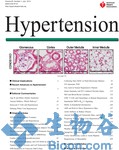2013年7月2日讯 /生物谷BIOON/–科学家开发出切除连接肾脏和脑的神经的新技术能够显著降低血压,有助于降低病人中风,心脏病和肾脏疾病。该过程副作用很小而且在治疗难治性高血压方面有了显著的效果。该技术发表在杂志Hypertension上。
布里斯托尔心脏疾病研究中心(BHI)心脏病学家Angus Nightingale博士和Andreas Baumbach博士将该技术命名为”去肾脏神经术”,该方法的过程是首先将一个细管插入病人腿部血管中,定位在负责供给肾脏的血管。传导的肾脏的神经就分布在血管周围,接着由细管发出的射线杀死血管周围的神经。该方法已经成功的在BHI的19位病人中进行了试验。
该最新方法是由布里斯托尔大学科学家和BHI心脏病学家共同完成的。科学家希望将该技术从实验室转到临床,造福众多的高血压病人。
BHI 高血压临床专家Nightingale博士称,我们采用去肾脏神经术治疗难治性高血压。我们发现病人血压降低到足以避免心脏病肾脏疾病以及中风的水平,该结果与基础研究类似。该治疗方法非常鼓舞人心。
Baumbach博士补充道,该技术非常直接有效,只需一天时间并且没有副作用。该技术将成为对降血压药物有抗性的病人的首选治疗方法。
布里斯托尔大学生理和药理学系教授Julian Paton博士称,长期服用降压药物会使得病人对其产生抗性,而且有可能出现抑郁等副作用。我们的新介入性疗法基于严格的基础实验,我们认为这是最有效的治疗高血压的方法。(生物谷Bioon.com)

doi: 10.1161/HYPERTENSIONAHA.113.01261
PMC:
PMID:
Translational Examination of Changes in Baroreflex Function After Renal Denervation in Hypertensive Rats and Humans
Emma C. Hart, Fiona D. McBryde, Amy E. Burchell, Laura E.K. Ratcliffe, Lesley Q. Stewart, Andreas Baumbach, Angus Nightingale, and Julian F.R. Paton
Renal denervation has shown promise in the treatment of resistant hypertension, although the mechanisms underlying the blood pressure (BP) reduction remain unclear. In a translational study of spontaneously hypertensive rats (n=7, surgical denervation) and resistant hypertensive human patients (n=8; 5 men, 33–71 years), we examined the relationship among changes in BP, sympathetic nerve activity, and cardiac and sympathetic baroreflex function after renal denervation. In humans, mean systolic BP (SBP; sphygmomanometry) and muscle sympathetic nerve activity (microneurography) were unchanged at 1 and 6 months after renal denervation (P<0.05). Interestingly, 4 of 8 patients showed a 10% decrease in SBP at 6 months, but sympathetic activity did not necessarily change in parallel with SBP. In contrast, all rats showed significant and immediate decreases in telemetric SBP and lumbar sympathetic activity (P<0.05), 7 days after denervation. Despite no change in SBP, human cardiac and sympathetic baroreflex function (sequence and threshold techniques) showed improvements at 1 and 6 months after denervation, particularly through increased sympathetic baroreflex sensitivity to falling BP. This was mirrored in spontaneously hypertensive rats; cardiac and sympathetic baroreflex sensitivity (spontaneous sequence and the Oxford technique) improved 7 days after denervation. The more consistent results in rats may be because of a more complete (>90% reduction in renal norepinephrine content) denervation. We conclude that (1) renal denervation improves BP in some patients, but sympathetic activity does not always change in parallel, and (2) baroreflex sensitivity is consistently improved in animals and humans, even when SBP has not decreased. Determining procedural success will be crucial in advancing this treatment modality.

